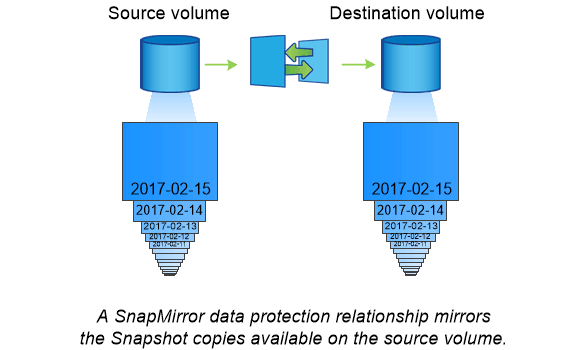SnapMirror disaster recovery and data transfer
 Suggest changes
Suggest changes


-
 PDF of this doc site
PDF of this doc site
-
 Cluster administration
Cluster administration
-
 Volume administration
Volume administration
-
 Logical storage management with the CLI
Logical storage management with the CLI
-
-
 NAS storage management
NAS storage management
-
 Configure NFS with the CLI
Configure NFS with the CLI
-
 Manage NFS with the CLI
Manage NFS with the CLI
-
 Manage SMB with the CLI
Manage SMB with the CLI
-
 Manage file access using SMB
Manage file access using SMB
-
-
-
 Security and data encryption
Security and data encryption
-
 Data protection and disaster recovery
Data protection and disaster recovery
-
 Data protection with the CLI
Data protection with the CLI
-
-
Collection of separate PDF docs
Creating your file...
SnapMirror is disaster recovery technology, designed for failover from primary storage to secondary storage at a geographically remote site. As its name implies, SnapMirror creates a replica, or mirror, of your working data in secondary storage from which you can continue to serve data in the event of a catastrophe at the primary site.
Data is mirrored at the volume level. The relationship between the source volume in primary storage and the destination volume in secondary storage is called a data protection relationship. The clusters in which the volumes reside and the SVMs that serve data from the volumes must be peered. A peer relationship enables clusters and SVMs to exchange data securely.

|
You can also create a data protection relationship between SVMs. In this type of relationship, all or part of the SVM's configuration, from NFS exports and SMB shares to RBAC, is replicated, as well as the data in the volumes the SVM owns. |
Beginning with ONTAP 9.10.1, you can create data protection relationships between S3 buckets using S3 SnapMirror. Destination buckets can be on local or remote ONTAP systems, or on non-ONTAP systems such as StorageGRID and AWS.
The first time you invoke SnapMirror, it performs a baseline transfer from the source volume to the destination volume. The baseline transfer typically involves the following steps:
-
Make a Snapshot copy of the source volume.
-
Transfer the Snapshot copy and all the data blocks it references to the destination volume.
-
Transfer the remaining, less recent Snapshot copies on the source volume to the destination volume for use in case the “active” mirror is corrupted.
Once a baseline transfer is complete, SnapMirror transfers only new Snapshot copies to the mirror. Updates are asynchronous, following the schedule you configure. Retention mirrors the Snapshot policy on the source. You can activate the destination volume with minimal disruption in case of a disaster at the primary site, and reactivate the source volume when service is restored.
Because SnapMirror transfers only Snapshot copies after the baseline is created, replication is fast and nondisruptive. As the failover use case implies, the controllers on the secondary system should be equivalent or nearly equivalent to the controllers on the primary system to serve data efficiently from mirrored storage.

Using SnapMirror for data transfer You can also use SnapMirror to replicate data between endpoints in the NetApp data fabric. You can choose between one-time replication or recurring replication when you create the SnapMirror policy. |



 Release notes
Release notes